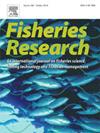Bitter crab disease dynamics in eastern Bering Sea Tanner and snow crab: An underestimated and emergent stressor
IF 2.3
2区 农林科学
Q2 FISHERIES
引用次数: 0
Abstract
Tanner crab (Chionoecetes bairdi) and snow crab (C. opilio) populations in the eastern Bering Sea have reached historic lows in recent years, and declines have been linked to recruitment failures and mortality events. Bitter crab disease, caused by a parasitic dinoflagellate (Hematodinium sp.), contributes to high mortality rates in Tanner and snow crab, and outbreaks have the potential to reduce recruitment and population productivity. Here, we employed a polymerase chain reaction assay to detect Hematodinium sp. in Tanner and snow crab hemolymph samples to: 1) evaluate testing accuracy of visual disease detection methods; 2) estimate bitter crab disease prevalence from 2015 to 2017 in eastern Bering Sea monitoring sites; and 3) identify factors influencing the likelihood of Hematodinium sp. infection. Our results indicated that visual diagnostic methods failed to detect 93 % of infections, and underestimated disease prevalence by up to 90 %. Infection risk was highly dependent on host size, sex and sampling date. Small Tanner crab (<30 mm carapace width) were nearly twice as susceptible to infection, and female snow crab were 9 % more likely to be infected than males. Most notably, bitter crab disease prevalence exceeded 50 % at two monitoring sites during the study period, and annual disease prevalence increased by approximately 10 % per year in both populations. We emphasize the severe population-level consequences for these high prevalence levels in eastern Bering Sea Tanner and snow crab stocks. Our approach highlights the critical importance of continued monitoring and mechanistic modeling of bitter crab disease in severely depressed crab populations.
白令海东部黑蟹和雪蟹的苦蟹病动态:一个被低估的和紧急的压力源
近年来,白令海东部的赤蟹(Chionoecetes bairdi)和雪蟹(C. opilio)种群数量已达到历史最低点,其下降与招募失败和死亡事件有关。由寄生鞭毛藻(Hematodinium sp.)引起的苦蟹病是造成坦纳蟹和雪蟹高死亡率的原因之一,其爆发有可能减少招募和种群生产力。本研究采用聚合酶链式反应法检测坦纳蟹和雪蟹血淋巴样本中的血液病,目的是:1)评价视觉疾病检测方法的检测准确性;2)估算白令海东部监测点2015 - 2017年苦蟹病流行情况;3)确定影响血吸虫感染可能性的因素。我们的结果表明,视觉诊断方法无法检测出93% %的感染,并且低估了高达90% %的疾病患病率。感染风险高度依赖于宿主大小、性别和采样日期。小赤蟹(壳宽30 mm)的易感程度是雄蟹的近2倍,雌雪蟹的易感程度是雄蟹的9 %。最值得注意的是,在研究期间,两个监测点的苦蟹病患病率超过50% %,两个种群的年患病率每年增加约10% %。我们强调白令海东部褐蟹和雪蟹种群的高流行率对种群水平的严重影响。我们的方法强调了在严重抑郁的螃蟹种群中持续监测和苦蟹病机制建模的重要性。
本文章由计算机程序翻译,如有差异,请以英文原文为准。
求助全文
约1分钟内获得全文
求助全文
来源期刊

Fisheries Research
农林科学-渔业
CiteScore
4.50
自引率
16.70%
发文量
294
审稿时长
15 weeks
期刊介绍:
This journal provides an international forum for the publication of papers in the areas of fisheries science, fishing technology, fisheries management and relevant socio-economics. The scope covers fisheries in salt, brackish and freshwater systems, and all aspects of associated ecology, environmental aspects of fisheries, and economics. Both theoretical and practical papers are acceptable, including laboratory and field experimental studies relevant to fisheries. Papers on the conservation of exploitable living resources are welcome. Review and Viewpoint articles are also published. As the specified areas inevitably impinge on and interrelate with each other, the approach of the journal is multidisciplinary, and authors are encouraged to emphasise the relevance of their own work to that of other disciplines. The journal is intended for fisheries scientists, biological oceanographers, gear technologists, economists, managers, administrators, policy makers and legislators.
 求助内容:
求助内容: 应助结果提醒方式:
应助结果提醒方式:


